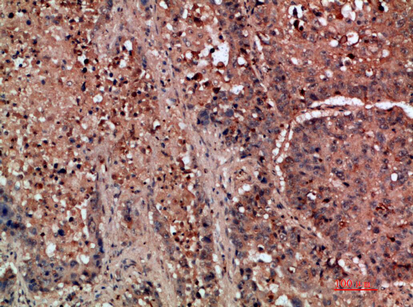DDR2 Polyclonal Antibody
- Catalog No.:YT5938
- Applications:IF;IHC;ELISA
- Reactivity:Human;Mouse
- Target:
- DDR2
- Gene Name:
- DDR2 NTRKR3 TKT TYRO10
- Protein Name:
- Discoidin domain-containing receptor 2 (Discoidin domain receptor 2) (EC 2.7.10.1) (CD167 antigen-like family member B) (Discoidin domain-containing receptor tyrosine kinase 2) (Neurotrophic tyrosine
- Human Gene Id:
- 4921
- Human Swiss Prot No:
- Q16832
- Mouse Gene Id:
- 18214
- Mouse Swiss Prot No:
- Q62371
- Immunogen:
- Synthetic peptide from human protein at AA range: 31-80
- Specificity:
- The antibody detects endogenous DDR2
- Formulation:
- Liquid in PBS containing 50% glycerol, 0.5% BSA and 0.02% sodium azide.
- Source:
- Polyclonal, Rabbit,IgG
- Dilution:
- IHC 1:50-200, IF1:500 ELISA 1:10000-20000
- Purification:
- The antibody was affinity-purified from rabbit antiserum by affinity-chromatography using epitope-specific immunogen.
- Concentration:
- 1 mg/ml
- Storage Stability:
- -15°C to -25°C/1 year(Do not lower than -25°C)
- Other Name:
- Discoidin domain-containing receptor 2 (Discoidin domain receptor 2) (EC 2.7.10.1) (CD167 antigen-like family member B) (Discoidin domain-containing receptor tyrosine kinase 2) (Neurotrophic tyrosine kinase, receptor-related 3) (Receptor protein-tyrosine kinase TKT) (Tyrosine-protein kinase TYRO10) (CD antigen CD167b)
- Background:
- Receptor tyrosine kinases (RTKs) play a key role in the communication of cells with their microenvironment. These molecules are involved in the regulation of cell growth, differentiation, and metabolism. In several cases the biochemical mechanism by which RTKs transduce signals across the membrane has been shown to be ligand induced receptor oligomerization and subsequent intracellular phosphorylation. This autophosphorylation leads to phosphorylation of cytosolic targets as well as association with other molecules, which are involved in pleiotropic effects of signal transduction. RTKs have a tripartite structure with extracellular, transmembrane, and cytoplasmic regions. This gene encodes a member of a novel subclass of RTKs and contains a distinct extracellular region encompassing a factor VIII-like domain. Alternative splicing in the 5' UTR results in multiple transcr
- Function:
- catalytic activity:ATP + a [protein]-L-tyrosine = ADP + a [protein]-L-tyrosine phosphate.,function:This tyrosine kinase receptor for fibrillar collagen mediates fibroblast migration and proliferation. Contributes to cutaneous wound healing.,similarity:Belongs to the protein kinase superfamily. Tyr protein kinase family. Insulin receptor subfamily.,similarity:Contains 1 F5/8 type C domain.,similarity:Contains 1 protein kinase domain.,tissue specificity:The major 10 kDa transcript is expressed in high levels in heart and lung, less in brain, placenta, liver, skeletal muscle, pancreas, and kidney.,
- Subcellular Location:
- Cell membrane ; Single-pass type I membrane protein .
- Expression:
- Detected in osteocytes, osteoblastic cells in subchondral bone, bone lining cells, tibia and cartilage (at protein level). Detected at high levels in heart and lung, and at low levels in brain, placenta, liver, skeletal muscle, pancreas, and kidney.
Crosstalk between cardiomyocytes and noncardiomyocytes is essential to prevent cardiomyocyte apoptosis induced by proteasome inhibition. Cell Death & Disease 2020 Sep 19 IF Mouse Cardiomyocytes
- June 19-2018
- WESTERN IMMUNOBLOTTING PROTOCOL
- June 19-2018
- IMMUNOHISTOCHEMISTRY-PARAFFIN PROTOCOL
- June 19-2018
- IMMUNOFLUORESCENCE PROTOCOL
- September 08-2020
- FLOW-CYTOMEYRT-PROTOCOL
- May 20-2022
- Cell-Based ELISA│解您多样本WB检测之困扰
- July 13-2018
- CELL-BASED-ELISA-PROTOCOL-FOR-ACETYL-PROTEIN
- July 13-2018
- CELL-BASED-ELISA-PROTOCOL-FOR-PHOSPHO-PROTEIN
- July 13-2018
- Antibody-FAQs
- Products Images
.jpg)
- Long, S., Gu, Y., An, Y. et al. Reovirus enhances cytotoxicity of natural killer cells against colorectal cancer via TLR3 pathway. J Transl Med 19, 185 (2021).

- Immunohistochemical analysis of paraffin-embedded human-lung-cancer, antibody was diluted at 1:200



